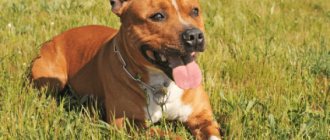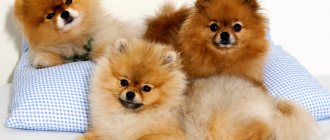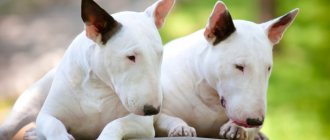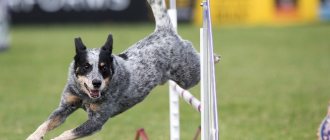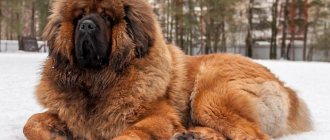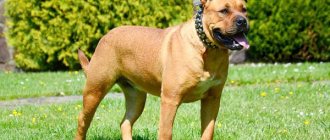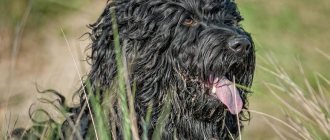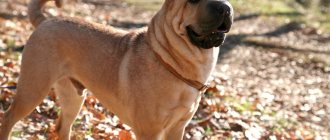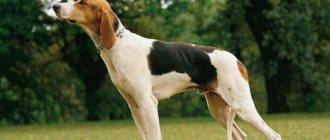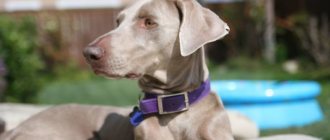There are other breeds of fighting dogs, but they all require the same attention, care, training and discipline. Since lack of education leads to injuries to other animals and the owners themselves.
A powerful and muscular dog requires a lot of energy. Therefore, due attention should be paid to creating a daily diet. Recommendations for nutrition are as follows:
- Dry food with a balanced composition is best suited. They contain the proper amount of carbohydrates, microelements and vitamins.
A strange superstition concerns that a dog should be fed exclusively meat. Experts recommend including 20% cereals and 20% vegetables in your diet.
Representatives of the breed
- Akita Inu is the calling card of the Land of the Rising Sun. This is the most famous breed in Japan and is considered the oldest in the world. They say that the first dog domesticated by man was Akita Inu. 20-35 thousand rubles per puppy
The American Akita is an offshoot of the Akita Inu breed, and the American traces its origins to the ancient Akita Inu dogs. From 700 to 100 US dollars.
The American Bulldog breed has been known since the 19th century. During its existence, this breed was called “Old English Bulldog”, “Country Bulldog”, etc., but this particular breed of dog is the closest in relationship to English Bulldogs. From 350 to 850 US dollars.
The American Pit Bull Terrier breed has been known for a long time; engravings depicting these dogs date back to the 15-16th century. The breed was originally bred for dog fighting. 200-400 US dollars.
The American Staffordshire Terrier breed has been known for a long time. These dogs appeared as a result of crossing Bull Terriers with Pit Bull Terriers. From 150 to 1000 US dollars
The English Bulldog belongs to the group of mastiff dogs; their ancestors were the fighting dogs of Ancient Rome. These dogs were also used for baiting bulls. In the last century, English Bulldogs have become family pets and companion dogs. From 500 to 1000 US dollars.
The first modern bull terriers appeared in Great Britain in 1895. Nowadays, these dogs are popular among breeders around the world; they have proven themselves to be excellent pets, protectors and friends of humans.
This breed is used in a variety of types of work. They rescue and protect, guard livestock and perform service. Acts well as a shepherd and can be an excellent watchman or rescuer.
The Cane Corso is considered one of the most ancient representatives of the Mollos (Mastiff-like) group. There are facts indicating that the ancestors of Cane Corso Italiano were ancient Roman fighting mastiffs, which were used at that time as dogs for 15,000 - 20,000 rubles per puppy
Pit bull terrier means fighting bull terrier. Pit bull terriers are often called pit bulls for short. But this is incorrect, since pit bull means fighting bull.
The breed comes from Germany, from the city of Rottweil, which is located in the south of this country. There is a version that Rottweilers trace their history back to the times of the Roman Empire, where they were fighting and racing dogs. From $300 to $500.
In the 18th and 19th centuries, French bulldogs were bred by poor peasants as light-type (small-sized) fighting dogs. This breed traces its origins to the Spanish Bulldogs - Alans (an extinct breed). over 15 thousand rubles.
A fighting or fighting dog, regardless of breed, can be any dog that takes part in fights. But breeders have developed several varieties in which they have specially developed the necessary qualities. Such dogs not only participated in battles with their relatives, but were also used to bait large and small game, and also accompanied their owners in military campaigns and wars.
Today, some breeds are prohibited in certain countries, and for breeding others, a special certificate is required to allow them to be kept. However, fighting animals are still quite common today, despite the fact that dog fighting is illegal. Representatives of these breeds can become loyal and friendly companions, but raising them will take much more time and effort from their owners.
- Show all
How to keep and care for a Bull Terrier
The breed is a smooth-haired dog, so you won’t need any complicated care. Your pet may shed twice a year. Wool can be easily removed with a brush or a special mitten.
After walks, you don’t need to bathe your dog; just wipe it with a sponge or damp towel.
This is interesting: Top 5 reasons why you can’t lose weight
Check your ears and eyes regularly for inflammation. Whites may have hearing problems. There are cases when puppies are born deaf.
The Bull Terrier's mobility indicates that it really needs to be exercised. Therefore, active walks, playing with a ball, jumping over the bar - all this is necessary to maintain the good physical condition of the dog. After such walks, the dog will be calm and docile. And with insufficient loads, don’t be surprised why he goes crazy and turns everything upside down.
Group of terriers
All of the dogs listed below belong to the terrier group. Some of the pedigree dogs were bred by breeders specifically to participate in dog fighting, while others were used to bait large game.
The list of fighting dogs that belong to this group is as follows:
| Breed name | Description | Animal photos |
| Bull Terrier | The most controversial breed, which is called the dog with a rat face. Some people consider bull terriers to be similar to pigs. Some breeders characterize the shark-faced, slightly humpbacked dog with a large nose and narrow eyes as one of the most bloodthirsty and evil, while others describe it as a peace-loving and friendly companion. These fighting dogs are friendly and are not naturally inclined to show unreasonable aggression. Cowardly and angry puppies are discarded from breeding | |
| American Pit Bull Terrier (Pitbull) | This breed is considered the best among fighting ones. The dog does not have a killer instinct, fights for the sake of excitement and extremely rarely injures his opponent. This breed is also great for keeping at home. With timely socialization and proper training, the dog becomes a friendly four-legged pet who adores children. | |
| Staffordshire Bull Terrier | The breed was bred in England in the 17th century. The Staffordshire Bull Terrier was created by crossing a Bulldog with an English Terrier. The dog was used to bait small rodents. The Irish working line of Staffords was used as fighting dogs. Now the dog is a companion. The Staffordshire Bull Terrier is very loyal to its owner and is not aggressive towards other dogs. |
Fighting Molossians
The ancestors of fighting dogs belonging to the Molosser group are ancient fighting dogs that took part in battles and baiting wild animals in the arena of Ancient Rome, Egypt and Assyria. All representatives are distinguished by a large physique, well-developed muscles, tall stature (up to 95 cm) and a sense of territory.
The Molosser group includes the following breeds:
| Breed name | Description | Animal photos |
| English Mastiff | The English Mastiff is the largest of the mastiffs. These large dogs from Great Britain took part in bear fights and gladiator fights. Over the years, breeders have managed to significantly adjust the character of dogs, so bloodthirsty, aggressive dogs have become friendly and balanced pets. Mastiffs love to play with children and forgive them any pranks. Dogs rarely bark and prefer to avoid conflicts. However, pets are excellent guards | |
| Ca-de-bo (Majorcan Mastiff) | Mallorcan Mastiffs are mistakenly classified as bulldogs. Despite the fact that bulldogs were used to restore the breed in the 20th century, mastiffs are the progenitors of the Ca-de-Bou. Strong dogs of medium height are excellent watchdogs. They are easy to train, have an extraordinary mind and get along well with children. | |
| Neapolitan Mastiff (Mastino Neapolitano) | Mastinos were previously used to take part in bloody battles, but now they serve as guards. Representatives of this breed are friendly and adore their owners. Since dogs are very jealous, it is not recommended to have them in families with children under 12 years of age. Mastino jealousy often manifests itself through aggressive behavior | |
| Bully Kuta (Pakistani Mastiff) | The Bully Kut has a complex character and is not recommended for inexperienced owners. Training a dog is difficult; the owner needs to be responsible and strong-willed in order to curb it. These dogs are great for guarding country houses. They cannot be kept in an apartment with small children and other animals. They behave very aggressively towards pets | |
| South African Boerboel | The breed is one of the most ancient. Its representatives have instant reaction, strength and incredible endurance. Dogs require daily exercise and long walks. Ignoring stress threatens that the dog will begin to show unreasonable aggression towards strangers and even towards the owner. Boerboels are very stubborn, they need a responsible, strong-willed owner whom the pet will respect | |
| Cane Corso (Italian Mastiff) | Modern representatives of this breed are focused on protecting and guarding the territory. Powerful, elegant dogs with pronounced muscles and strong bones are easy to train and have an innate protective reflex. The Cane Corso has highly developed intuition. Thanks to her and her extraordinary intelligence, dogs can easily distinguish a real threat from a game and make their own decisions. They do not attack without a serious reason or command from the owner. They try to make friends with household members and other pets, they love small children | |
| Dogo Argentino (Argentine Mastiff, Dogo Argentino) | It is the only officially registered dog breed bred in Argentina. Despite the fact that dogs are considered guards and companions, in fights with their brothers they have defeated dogs such as Staffordshire and pit bulls. Great Danes have a calm disposition, but require early socialization. Other animals may be perceived as prey. They love to spend time with their owner and treat everyone in the household equally well. | |
| Dogue de Bordeaux (French Mastiff) | In the past, Dogues de Bordeaux were fighters, but now they are loyal companions. Dogs are distinguished by their balance, endurance and stubbornness. However, they are inactive. They get along well with other pets, but only if they were raised with them from an early age under the same roof. |
Other breeds similar to rats and pigs
A flat and straight nose is a basic characteristic of most breeds. These include:
- Cardigan Welsh Corgi. This dog is small with long hair. There are several different varieties of the breed. The main feature is a maximum weight of only 20 kg, height no more than 35 cm. Despite this, the baby has good endurance and a strong physique. The color varies significantly. As for behavior, a pet becomes active and cheerful with proper training.
- The Miniature Pinscher is considered a small copy of the Doberman Pinscher. The difference lies in the small size. The breed appeared about 300 years ago.
When choosing, you need to pay attention not only to the appearance of the dog, but also to its character. Proper upbringing allows you to grow a bull terrier into a cheerful friend and a loyal guard. Despite their menacing appearance, representatives of this breed are friendly and affectionate. However, it is worth considering that such a dog does not get along with other pets.
The Bull Terrier breed is a dog with an elongated muzzle. Opinions about this breed are divided into two types: some consider the dog aggressive and dangerous, while others describe it as a devoted friend and an excellent protector.
Wolfhound class
Initially, the following breed dogs of the wolfhound class were intended to protect the territory and were often used as herding dogs. But due to the popularity of dog fighting, these dogs were used to participate in bloody battles with their relatives. They attracted the attention of people involved in their organization with their impressive size and physical strength. Now that bloody spectacles are prohibited by law, dogs are again being used for their intended purpose.
Fighting dogs include the following representatives from the wolfhound class:
| Breed name | Description | Animal photos |
| Gampr (Armenian wolfhound) | An indigenous breed of dog that is practically not subject to selection. The weight of these large dogs reaches about 60-70 kg. Gampras have well-developed working qualities, which allows them to be used to protect territory and herds. Dogs are independent and have a strong attachment to their owner. Dogs consider themselves full members of the family, especially if they live under the same roof with the owner. | |
| Alabay (Central Asian Shepherd Dog, SAO, Turkmen Alabay) | The famous breed of herding dogs was bred for guarding and driving livestock, but was also used to participate in battles. The dog has endurance and a willful character. He needs an experienced owner who will understand the specifics of the breed. Training requires professional skills, since the Alabai requires an individual approach. With proper training, the dog will become an excellent guard of the territory, not showing unreasonable aggression. | |
| Caucasian Shepherd (KO) | A herding and guard dog breed used in underground dog fighting. According to the type of coat, KOs are divided into 3 types - with long, intermediate and short hair. The dog is distinguished by its balance and determination. Its main purpose is to protect the territory; keeping it in an apartment is highly not recommended. A dog can also become a bodyguard, but in this case it requires special training | |
| Kangal Karabash (Turkish Kangal, Turkish Cattle Dog, Turkish Wolfhound) | One of the most ancient shepherd breeds. They tried to use the dogs as fighting dogs, but they did not show themselves properly. Unlike its fighting relatives, Karabash has a calmer disposition. The dog can become an excellent companion and protector |
Rat as a pet
Gray rats are easily tamed and bred as pets and test animals. Decorative rats are friendly towards people, omnivorous and clean, so caring for a pet rodent does not cause any special problems. It is important for all potential owners of rats to take into account that they are social animals and keeping rats alone will cause psychological stress in the animal.
- During the Middle Ages, when a rat invasion was comparable to a natural disaster, in German cities rat catchers who presented 5 thousand rat tails were awarded special privileges.
- On the islands of Oceania, the small rat is bred as a pet for food.
- Karni Mata is an Indian temple where rats are welcomed, revered, fed, watered and protected in every possible way. A visitor who accidentally kills a sacred animal is required to bring to the temple a golden figurine in the form of a rodent.
- The gray rat consumes about 12 kg of food per year, but spoils much more. According to experts, the entire harvest of every 6 farmers goes to feed rats.
- In the US state of Illinois, it is illegal to “hit a rat with a baseball bat.” Violators face a fine of $1,000.
- In countries such as China, Vietnam, Thailand, India, Cameroon, Laos, Myanmar, Cambodia, Mozambique, Ghana, Nigeria, and in some areas of the Philippines and Indonesia, rats are eaten. They make soup from the rodents, dry them, and also cook the rats on the grill, first singeing the animal’s thick fur, which, when ignited, spreads an unpleasant odor. At the same time, people distinguish the taste of different types of rats and consider rat meat a delicacy, which, by the way, in some African countries is cheaper than beef or fish.
Rats and mice belong to the order Rodents. If you don’t know the difference between them, it’s easy to confuse the animals. This will lead to an erroneous choice of means of destruction. Adults are characterized by different sizes: a rat is larger than a mouse. At the initial stage of development, young animals are more difficult to distinguish. To understand who is found in the house, they first study the features of the rodent’s body structure.
Small animals of several species are found in residential buildings. A house mouse lives near a person, as well as a gray, black or red rat.
The difference between rodents becomes noticeable if we evaluate each body parameter separately:
- Dimensions. When thinking about what ordinary rats look like, the image of a large-bodied animal immediately comes to mind. The body length of this rodent reaches 30 cm. The mouse is smaller in size, the average individual is characterized by a length of up to 10 cm.
- Weight. Given the difference in size, it is logical to assume that the mass of animals also differs. For example, a mouse weighs between 30 and 50 g, while a fellow rat reaches 900 g.
- Tail. Differs in length and thickness. This part of the mouse's body is shorter. You should also pay attention to the thickness. The mouse has a thin tail, while large rodents have a thick tail, which is more noticeable at the base. In addition, it is not covered with fur. The mouse tail is also different: it is hairy, and the color matches the color of the body.
- The eyes of the mouse are larger.
- Rodent ears also vary in size, shape and location. For example, in a mouse they are round, wide, and directed to the sides. Rat ears are flattened and distinguished by a small base.
- The shape of the head is also different. The muzzle of a rat is elongated, while that of a mouse is triangular in shape.
Relative to the head, the rat's eyes are small. Mice have more expressive and slightly convex black eyes.
In addition, pay attention to the wool. In addition to color, there are other differences. The rat is characterized by hard hair, and the mouse has softer hair.
Rats, unlike mice, are able to jump high - up to 2 meters in extreme situations. They are highly intelligent
Differences between a mouse and a rat
The main feature of a newborn rat pup is its larger body size. This is noticeable upon birth. The mouse is always smaller. The main characteristic differences between rodents are the same as in adults: the shape of the ears, the color of the emerging fur, etc. Sometimes a baby rat is confused with an adult mouse.
To avoid this mistake, you should find out how they differ:
- A rat at an early stage of development is characterized by a blunt snout, while a mouse has a pointed head shape.
- The baby rat's tail has not yet developed enough, which means it is shorter than that of an adult mouse.
- The ears of baby rats are still small and smaller in size than the hearing organs of adult mice.
- There are still skin folds on the soles of the baby rats, while they are absent in the mice. This feature allows you to determine the difference from rodent tracks.
A distinctive feature of rat pups is their blunt-nosed, as if chopped off muzzle.
Baby rats and adult mice have similar paw sizes, but the placement of the toes is an additional characteristic that can be used to distinguish rodents.
Fighting bulldogs
This fighting dog breed has been known since the end of the 19th century. American Bulldogs are one of the closest relatives of the Old English Bulldogs.
This breed has undergone virtually no selection. Muscular dogs of medium height are distinguished by a high level of intelligence and well-developed guarding qualities. Initially it was used as a fighter, and later as a watchman. The Bulldog is highly trainable, but can be stubborn. Loves children and is reserved towards strangers.
Representatives of this breed have difficulty getting along with their relatives and display dominant behavior. Owners are advised to socialize their puppy from an early age and introduce it to other animals.
One of the smallest fighting dogs is the French bulldog.
Their ancestors were also English bulldogs.
The description of the breed is as follows:
- proportionate, stocky build;
- short muzzle and flat nose;
- erect ears;
- short coat;
- naturally shortened tail.
French bulldogs are distinguished by their balance and intelligence. Dogs are friendly towards strangers. They do not always find a common language with other animals and can show aggression towards them. Early socialization will help correct their behavior.
Character
Now let's figure out whether a dog with a rat's face is really dangerous. The Bull Terrier breed is distinguished by strength and agility. Its relationship with a person, like that of other dogs, depends 99% on how the puppy is raised. If from a very early age he understood that the owner is the leader, whose obedience must be unquestioning, then it is difficult to find a better friend.
The Bull Terrier breed, or rather its representatives, has the following characteristics: they are playful, restless and active creatures. If you decide to get a bull terrier, get ready for many hours of daily walks. Therefore, such a dog is more suitable for energetic and young owners.
View gallery
If, when you mention the name of this breed, you imagine a dog with a rat's muzzle, this means that you have come under the influence of the black PR launched in our press regarding this animal in the late 90s. In fact, he is a cheerful, cheerful and quite likeable dog.
Contrary to journalists' claims, the bull terrier has a high level of intelligence. Yes, he is capricious and jealous. Will not obey if he considers the owner's commands to be unreasonable. The owner will need love, patience and care to raise the dog correctly. We must not forget that she needs early socialization. Since this is a very intelligent dog, it will happily respond to a friendly and kind attitude and will readily obey a fair owner.
American Akita
The large Japanese dog (American Akita) was brought to the United States from Japan. The heavy-boned dog was originally used in hunting as a baiting dog.
The animal is friendly to household members and strangers. The American Akita is very loyal to its owner and can serve as a companion or guide dog.
She never attacks first and enters into battle if she or her owner is in real danger. The dog is silent and good-natured. She gets along well with other pets and does not harm children.
Bandog
The American Bandog was originally bred specifically to participate in battles, but later it was retrained as a watchman. Breeders got the dog by crossing a Neapolitan mastiff with a Staffordshire terrier. The name of the breed literally translates as “chain dog.”
The height of the dog at the withers is no more than 73 cm. The physique is muscular and strong. Bandogs have a capricious character. If the pet is not in the mood, then he will not allow household members to play with him. He treats family members with restraint and recognizes only the owner. He will not forgive children for pranks, so it is highly not recommended to keep him in a house where children live.
In battles, the dog showed rapid fatigue, which is why it was almost immediately stopped being used as a fighting dog. The peculiarity of this purebred dog is that during a walk he may have a desire to protect the strangers around him.
Raising a puppy
The Bull Terrier is a hyperactive dog, so you need to start training your puppy from the first days of his arrival in your home. The new resident should have a place to rest, a designated place for food, where there should be bowls for food and water.
First of all, the owner must make it clear to the baby that he is the master of the house. You cannot follow the puppy’s lead, allowing him to climb onto the sofa or beg at the master’s table. Small bull terriers are very smart. They quickly understand that they cannot take food from strangers or pick it up from the ground, etc. If you understand that you cannot raise a puppy on your own, contact a professional dog trainer.
Brindisian
One of the most unusual and rare breeds is the Brindisian fighting dog, or Brindisian.
The dog was bred to participate in dog fighting by crossing an American Pit Bull Terrier, a Rottweiler and a Neapolitan Mastiff. In some countries, due to its aggressiveness, this breed is prohibited for import and breeding.
Fighting dogs are a group of animals that were bred specifically for fighting. The desire to pit dogs goes back to the 18th century. It was then that a new noble pastime appeared - setting dogs on a bear or other wild animal. Man has long been drawn to bloody fights. Subsequently, it became problematic to obtain animals and it was decided to arrange fights between dogs. But before fighting dogs came to the attention of the nobility, they began their formation at the very “bottom” of London.
Fighting dogs are a group of animals that were bred specifically for fighting.
History of the appearance of animals
The lower strata of English society came up with a new pastime. Rats were released into a fenced area, and then the betting owner took bets on how long and how many rats his dog would kill. The show was a huge success and brought good income to the dog's owner. There was also a positive aspect - the rat population decreased. English bulldogs and terriers were the most successful rat killers. To enhance their fighting potential, these species were crossed. As a result, a new breed was created - the Bull and Terrier. She was gaining strength, and chasing rats became boring. Then the dog owners decided to organize dog fights.
Today, fighting dogs are distinguished by a strong physique with well-developed muscles and stately posture. Dog fighting is banned in almost all countries and is considered animal cruelty. This type of entertainment has gone underground. Many continue to raise and educate dogs of this species.
When studying fighting dog breeds, the list of which is numerous, one should also consider their characteristics.
Alabai – big and cheerful
This name is not entirely correct; it refers to the color of the dog. The real name is Central Asian Shepherd Dog. The breed is distributed over a vast territory from the Caspian Sea to China, from the Urals to Afghanistan. Its homeland is Central Asia. This is the oldest dog in the world. It is considered a national treasure of Turkmenistan; there is even a ban on its export. It is also called a wolfhound. And today the shepherds of Asia believe that they cannot find a better flock guardian. A dog of this breed can easily cope with several wolves at the same time.
Main characteristics of alabai:
- power and strength;
- good health;
- thick and rough skin;
- steel jaws;
- healthy respiratory system;
- the fighting qualities of the winner are developed.
- the muscles are so developed that they protrude from under the skin;
- the head is massive and heavy, the jaw is highly developed;
- ears are high and do not need cropping;
- hind legs widely spaced;
- the tail is not docked.
The pit bull was persecuted for a long time for its aggressiveness, and as a result, its main fighting qualities were lost. Today, the fighting dog often becomes a pet. How the dog will grow up depends on the person himself: only education and a competent approach to the animal will allow you to get a kind and patient family member.
Bull Terrier is a real fighter
The Bull Terrier breed was created to win. Rare battles can take place without the participation of these dogs. Fighting dogs had to be aggressive and strong. But this does not mean that outside the fighting ring they behave this way. The appearance of the bull terrier is interesting. He is short, his legs are short and muscular, his muscle mass is well developed, he is distinguished by agility and jumping ability. The head is shaped like an egg, which is why the bull terrier has a firmly established nickname - a dog with a rat face.
Fighting dogs are not a separate breed. This is the name of some breeds created to help humans, which people chose to participate in dog fights in the arena. Fighting dogs do not become such from birth - this is the result of the development of anger, endurance and thirst for battle in animals from puppyhood (as soon as they are taken from the bitch). Some parenting techniques may seem cruel and completely unacceptable. At the same time, in civilized countries, training hunting dogs to kill animals is popular; tens of thousands of spectators are attracted to bullfights that are far from humane. Therefore, without dwelling on moral issues, let’s figure out what breeds of dogs are called fighting dogs and why.
Fighting dogs are not a separate breed. This is the name of some breeds created to help humans, which people chose to participate in dog fights in the arena
The list of fighting dogs is headed by the American Pit Bull Terrier (translated as fighting bull terrier). His ancestors are a bulldog (bull dog) and a terrier, from them he inherited strength and instant reaction.
At the end of the 19th century, pit bulls were used to bait bulls and bears
Pit bull terrier (abbreviated as pit bull) had other names:
- pit dog;
- Bull Terrier;
- Yankee Terrier.
Until the end of the 19th century, pit bulls were used to bait bulls and bears, and later as fighting dogs. reaches a height of 60 cm, weighs up to 30 kg, can have different colors, is muscular and can withstand heavy loads. The undeniable qualities of a pit bull are intelligence, courage, agility and mobility. The pit bull has a keen sense of smell, which allows it to be used to search for explosives or narcotic substances. He is easy to train at any age.
A pit bull can consider all small animals as its prey and hunts them, but it can be weaned and distracted from aggression towards other animals. However, if another animal starts a fight, the pit bull is unlikely to back down, as the excitement of the fight is inherent in it. His pain threshold is very high.
There is an opinion that a pit bull has a death grip, that its jaws lock when it bites. At the University of Georgia, veterinarians conducted research on American pit bull terriers on this issue. As a result, it was established that the functional morphology of the pit bull and representatives of other breeds are identical.
The strength of the bite depends on the animal's temperament and experience.
Usually, a pit bull easily changes owners, especially if it finds itself in better conditions. Often, they take into the home not a puppy, but an adult pit bull with an already formed character.
Owners adore their pit bulls, considering them affectionate and good-natured. But people are afraid, because these dogs have a bad reputation due to irresponsible owners who specifically raise animals that are aggressive towards humans. Today, pit bulls are banned in the European Union and Australia, although 100 years ago they were fashionable and popular pets. If you carefully approach the training of a pit bull, it will be no more aggressive towards people than any other breed.
Maintenance, care
The maintenance of these large pets begins with preparing a place for it, which is not recommended to be changed in the future.
Since the Great Dane puppy will grow into a huge dog in the future, he needs a lot of space in the apartment, as well as a lot of free time from the owner for joint activities with the pet. Therefore, if the apartment is small, or all family members are too busy, then it is better not to purchase a Dog. It is also not recommended to get this particular dog if the novice dog breeder has not previously had experience raising these particular pets. After all, raising and training these huge and sometimes very stubborn dogs requires from the dog breeder not only time, but also skill, as well as strength, patience and a certain character, so that the dog can feel who is in charge in the house.
These pets (due to their large size) require long daily walks. And if the puppy should not be forced against his will to take long walks, then older pets themselves are willing to go for walks with the owner. Moreover, when walking different subtypes of Dogs, it is better to alternate between just walking and jogging. The best place for walking is on hard ground, where the dog can run calmly without knocking its paws.
Great Dane subspecies with long legs can often have joint problems, so you should be careful about the appearance of even mild lameness. Also, such dogs are prone to colds, so there should be no drafts in the place where your pet will rest, and you should also provide him with soft bedding.
You need to bathe your Great Dane when it gets dirty, and you need to brush it daily. It is better to use a special massage brush for this.
Feeding
It is better to feed such dogs homemade food. But it should be remembered that in the spring and summer the diet should contain less food rich in proteins and carbohydrates, but in the fall and winter the amount of such food is increased. As the puppies grow, the amount of food increases in proportion to the dogs' growth.
The puppy at home continues to be fed the same food that he received from the breeder, but gradually you can accustom him to an adult diet. Such large breeds need meat in sufficient quantities, but it is better not to feed chicken.
Upbringing
It is better to start raising such proud and slightly stubborn pets from the first day the puppy appears in the house. The main thing is that the puppy gets used to the owner and trusts him completely.
Important! These dogs are highly intelligent and quickly remember commands. Training puppies should begin with walking on a leash - these dogs do not like this procedure, so they should be taught without shouting, rewarding them for the slightest achievement
Gradual training of a puppy in the rules of behavior in the house and on walks can begin from childhood, but serious training begins no earlier than the dog is six months old. It is better to take the Dog to an experienced instructor at the first stage of training - he will teach the dog basic commands and tell the owner how to practice them correctly at home or on a walk.
Parenting mistakes
Obvious mistakes in education include:
- irregular exercises with the dog;
- intemperance of the owner, practicing commands in a raised voice, frequent assault when the pet disobeys;
- training this large pet in crowded places, if the dog is not yet sufficiently trained.
Four-legged sumo wrestler
Tosa Inu is heavy, fearless, and feels little pain.
It has a height at the withers of up to 60 cm, weighs 40-80 kg. They appeared at the end of the 19th century as a result of crossing a local dog used for hunting wild boars with European ones. Selective selection has been carried out for many years in order to obtain a dog with the best fighting qualities. , having the strength and weight of a mastiff, is very agile and resilient. This animal has a very strong and independent character, constantly striving to prove its dominance, so the dog is recommended only to those who have the skills to communicate with fighting dogs.
An improperly raised puppy will grow up to be an aggressive dog with unpredictable behavior. Tosa Inu are prohibited in Norway and Denmark.
Usually, a pit bull easily changes owners, especially if it finds itself in better conditions.
In Japan, Tosa Inu dogs are permanent participants in popular fights that take place in special premises where the animals are also bred and trained. Dog fighting in Japan is a civilized spectacle with its own rules and regulations. The main thing is that bloodshed and injury are not allowed here: a fighter who barks, bites, and wounds an opponent to the point of bleeding, will be disqualified forever. Only males take part in battles. The winner is the one who knocks the enemy down and crushes him with his weight. Tosa Inu fights silently, without growling. In terms of spirit, courage and endurance in the ring, Tosa Inus are compared to sumo wrestlers and are also awarded champion titles.
Tosa Inu fighting dogs are loyal to their owner and very intelligent. They are used for security, in search and rescue operations and in therapeutic canine therapy.
The complex nature of the Bull Terrier requires a gentle, patient and consistent attitude
Health and life expectancy
Most purebred dogs have congenital defects that are a consequence of selection. They experience health problems, but knowledge of hereditary diseases helps owners keep the situation under control and visit the veterinarian on time.
What diseases are typical for bull terriers? Anatomical defects are now quite rare. Some dogs may experience partial or complete deafness, blurred vision, and kidney problems. Such deviations are considered breed defects; dogs with congenital diseases are not allowed to reproduce.
Bull Terrier: a dog named Death
There are so many conflicting opinions about any other dog as about the bull terrier. Some call the dog a good-natured dog, others consider him a murderer who tears apart children. Another name for the bull terrier is “rat-faced dog.” It was bred in the middle of the 19th century by crossing a Dolmatian Great Dane and a white terrier in order to obtain a rat catcher. The dog turned out to be strong and resilient, of medium size (height at the withers up to 55 cm) with a special (egg-shaped) head shape. A rat caught in the bull terrier's field of vision has no chance of life.
The complex nature of the Bull Terrier requires a gentle, patient and consistent attitude. It cannot be subdued by force; attempts to force a bull terrier to do something against its will can be dangerous both for the owner and for those around him.
You need to walk with him in the morning and evening, loading him physically and giving him an outlet for energy.
At the end of the 19th century in England, bull terriers were companions of wealthy townspeople, popular with teachers at Oxford University. At the end of the 20th century, they began to be actively used as fighting dogs. In the 90s of the last century, when it was very prestigious to purchase an unusual dog, many bred bull terriers as decorative ones and did not train them, which led to manifestations of aggression in the animals. In addition, breeders, wanting to get as many puppies of a popular breed as possible, allowed animals to breed every heat, starting from the first, often using hormonal stimulants. As a result, defective puppies grew into dogs with defective psyches.
The media fanned hysteria around the very fact of the existence of bull terriers, often telling tales about them, calling them a dog named “Death”, a killer. Society has developed a strong opinion: the bull terrier is extremely dangerous. The animals were euthanized. And it was necessary to start with the education of the owners, since problems in the dog’s behavior are associated with the behavior of the owner.
List of fighting dog breeds and their characteristics
When getting a dog, keep in mind that a fighting dog will strive to become a leader and dominate. If a person does not make it clear that he is the boss here, the animal will definitely bite one of the family members, rightfully the strongest in the pack. Not every person is able to curb a strong-willed and incredibly strong dog.
There are about 30 fighting dog breeds in the world, the list of the most dangerous of them and prohibited in different countries is not so long. It includes the following:
- Preso Canario.
Height up to 63 cm, powerful, seems squat due to the elongated body, but very dexterous. It was used as a herding dog, for hunting big game, slaughtering livestock and fighting. Banned in Australia and New Zealand in 2001 after two dogs of this breed mauled a 33-year-old man in the lobby of a building. - The Dogo Argentino is the symbol of Argentina.
Bold and powerful, up to 68 cm tall, looks like a pit bull. The breed was bred to hunt mountain lions. After a long pursuit of the beast, the dog could enter into a fight with it. Recognized as one of the best in the world for guard duty. It has only white color. Owners of the Dogo Argentino consider it a wonderful friend, but it is banned in 10 countries. - Czechoslovakian Wolfdog ().
It was developed in 1958 in Czechoslovakia as a result of crossing the Carpathian. An intelligent and resilient dog, capable of running at a speed of 10-13 km/h for 8 hours without rest. Does not bark, prefers to howl, has a wolf coloration. Its height at the withers is up to 75 cm. It is used in search and rescue operations and guard duty. Its character is unpredictable: it can attack people, especially children, considering them easy prey. Banned in Norway. - The American Bandog (chain dog)
is a dog with slanted eyes, height at the withers is up to 73 cm. Bandog was received for fighting. Once you see him, you will no longer confuse him with any other dog. Muscular, but during fights he showed rapid fatigue. While walking, he may have a desire to protect the strangers around him - then it will be difficult to restrain him. Bandog is prohibited wherever its parents are prohibited: and. - Owners of Caucasian Shepherds, Alabais, and Rottweilers
are surprised to learn that seemingly formidable dogs, their affectionate, intelligent and obedient pets, are banned in one country or another due to aggressive and inappropriate behavior.
At the end of the 19th century in England, bull terriers were companions of wealthy townspeople, popular with teachers at Oxford University
Experienced dog handlers are confident that if a person is treated cruelly, any type of dog can become aggressive, even the smallest.
Appearance of a dog with a rat face from a photo
Due to the unusual shape of the muzzle, many consider the animal to resemble a rat. The head of these fighting dogs is large, the upper part is almost flat, the tip of the nose is blunt and slightly down.
The eyes are narrow, small, and deep-set, which is why they are compared to the eyes of a pig. The ears are thin, set close to each other. They must stand upright. The lower jaw is large and strong. The teeth have a scissor bite; They are large, sharp, and it is not for nothing that they say that the dog has the grip of a shark.
The dog's body is strong and muscular. The chest is wide, muscles are visible under the skin. The chest is lower to the ground than the stomach. The back is powerful, but short. The body has a round and compact shape.
The limbs are of medium length, dense and muscular, with strong bones. The front legs, like the hind legs, are parallel to each other. The knees are flexible and mobile. The tail is short, tapering towards the end and directed downwards.
According to the breed standard, coat color can be either white or colored. White dogs may have colored spots, but they should not stand out too much on the coat. The eyes are dark brown; light color is considered a defect. The photo below shows that bull terriers actually have little in common with rats.
